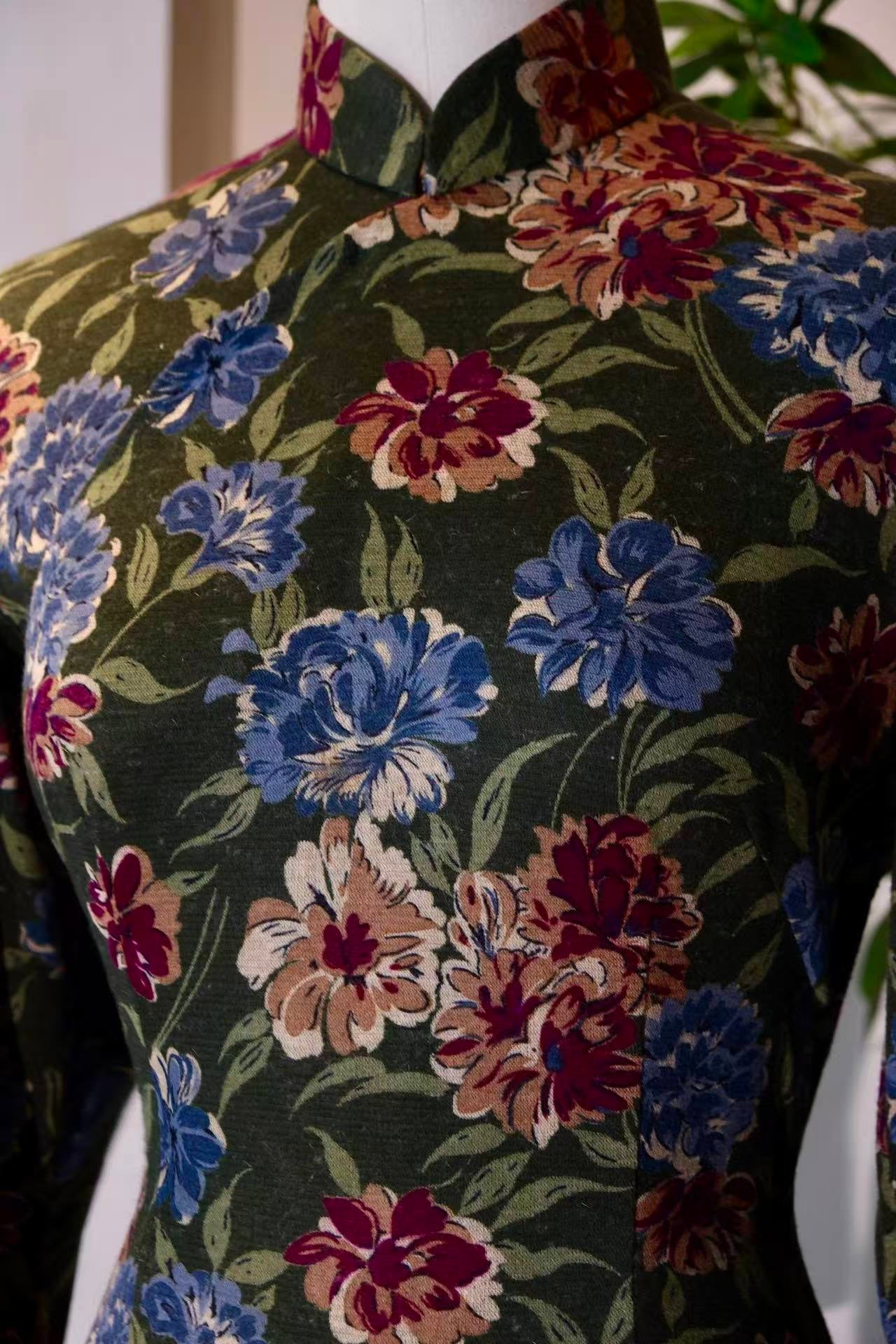深圳溯源
60年代 - 上世纪六十年代香港针织印花古董旗袍 | 1960s - A Sixties Hong Kong Knitted Printed Antique Cheongsam
60年代 - 上世纪六十年代香港针织印花古董旗袍 | 1960s - A Sixties Hong Kong Knitted Printed Antique Cheongsam
Couldn't load pickup availability
分享一件上世纪六十年代香港针织印花古董旗袍艺术赏析。
螺青底色铺展成一幅烟波浩渺的江南画卷,针织印花棉的肌理间,
蓝白渐变的月季如水墨晕染,花瓣边缘微微卷曲,似带露初绽;
螺青底色取自明代青花瓷的“积胜蓝”,沉静如深潭,
1960年代的香港旗袍,在延续民国“立领、盘扣、修身剪裁”
这种风格恰是香港作为“东西方文化转口港”的缩影:
此件旗袍的螺青色在当时属“高级定制色”——
今日展于眼前的,不止是一件衣物,更是一段被面料封存的时光:
🎨 Art Appreciation of a 1960s Hong Kong Knitted Printed Antique Cheongsam
This antique cheongsam, created in the 1960s, is an embodiment of cross-cultural artistry, where the deep conch blue (螺青) background unfolds like a vast, mist-covered landscape of Jiangnan (Southern China). The texture of the knitted printed cotton bears the subtle glow of half a century of craftsmanship from Hong Kong fashion ateliers.
I. The Tapestry of Print: East Meets West
The fabric blends the techniques of Chinese traditional flower-and-bird painting with Western modern color-blocking:
-
Aesthetics: The design utilizes the "scattered perspective" (散點透視) of traditional Chinese painting and the "color block and plane" technique of modern Western print to create a vibrant, all-over garden scene:
-
Roses (月季): Rendered in blue-and-white gradient, like ink wash spreading on rice paper. Their slightly curled edges suggest a fresh, dewy bloom.
-
Peonies (芍藥): Layered like clouds in crimson-red (绛红), their centers dabbed with gold powder, recalling the fine-line tradition of "drawing the flower and dotting the leaf" (勾花點葉) from ancient Gongbi (meticulous) painting.
-
Camellias (山茶花): Executed using the mogu (boneless) technique in white and pink, their round petals appear saturated with spring light.
-
Interplay: These are interwoven with scattered deep-red Chinese crabapples (海棠) and emerald-green leaves, forming a vibrant "Poetry Society of Flowers" (花中詩社).
-
-
The Conch Blue Base (螺青): The background hue is borrowed from the prized "accumulated cobalt blue" (積勝藍) found in Ming Dynasty blue-and-white porcelain. While as profound and still as a deep pool, the elastic texture of the knitted fabric allows light to shift and flow over the surface.
-
The Clash and Harmony: The flowers—in blue, red, pink, and green—are precisely arranged through manual stencil printing (手工套版印花). The contrast between warm and cool colors creates a tension that is both clashing and harmonious, perfectly mirroring the cultural collision between "traditional foundations and modern trends" in 1960s Hong Kong fashion.
II. Structural Modernity: The "Swinging Sixties" Silhouette
While retaining the classic structure of the Republican-era cheongsam—the Mandarin collar (立領), frog fasteners (盤扣), and slim fit (修身剪裁)—the 1960s Hong Kong design subtly integrated the principles of Western tailoring, notably the architectural cut of Dior’s "New Look."
-
Tailoring: The cheongsam precisely delineates the female figure with an accurate waist-to-hip ratio.
-
Sleeve Detail: The slightly flared "trumpet sleeves" (小喇叭袖) maintain Chinese decorum while discreetly aligning with the fashionable rhythm of the Western "Swinging Sixties."
III. Cultural Crucible: The East-Meets-West Port
This style is a microcosm of Hong Kong's role as a "cultural transshipment port" between East and West:
-
It retains the elegance and refinement of the Shanghai cheongsam heritage.
-
It incorporates the bright, lively patterns of Southeast Asian (Nanyang) design due to local designers' keen observation of tropical flora.
As noted in the contemporary Hong Kong Ling Long magazine:
"The Qipao is not merely an item of clothing; it is a flowing scroll of Chinese aesthetics captured in a single garment."
IV. Rarity and Historical Significance
-
Color Rarity: The conch blue (螺青) shade was considered a "Haute Couture Color" at the time, requiring multiple vegetable dye baths, making it far more costly than common indigo.
-
Motif Lineage: The "garden print" motif traces its lineage back to the flower-and-bird patterns of Qing Dynasty Canton enamelware (廣彩瓷), continuing the Lingnan region’s aesthetic concept of "unity of man and nature" (天人合一).
V. The Eternal Whisper
What lies before us is more than an garment; it is a moment sealed in fabric.
-
Narrative: Whose elegance did it once shroud? On which night, beneath Victoria Peak, did it sway under the ballroom lights?
-
Legacy: As the conch blue base and the garden print gleam under the light, one can almost hear the tide of Hong Kong half a century ago, and the quiet whispers about beauty and life. This is the most moving quality of the antique cheongsam: it uses its pattern as a historical record and its fabric as a voice, forever young and forever swaying in the long river of time.
Share









